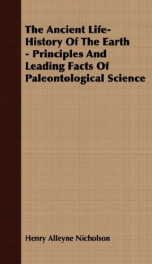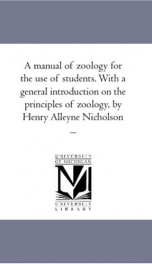The Ancient Life History of the Earth

THE ANCIENT LIFE-HISTORY THE EARTH THE ANCIENT LIFE-HISTORY THE EARTH A COMPREHENSIVE OUTLINE OF THE PRINCIPLES AND LEADING FACTS OF PALEONTOLOGICAL SCIENCE BY H. ALLEYNE NICHOLSON M.D., . PREFACE. THE study of Palaeontology, or the science which is concerned with the living beings which flourished upon the globe during past periods of its history, may be pursued by two parallel but essentially distinct paths. By the one method of inquiry, we may study the anatomical characters and structure of the innumerable extinct forms of life which lie buried in the rocks simply as so many organisms, with but a slight and secondary reference to the time at which they lived. By the other method, fossil animals are regarded principally as so many landmarks in the ancient records of the world, and are studied historically and as regards their relations to the chronological succession of the strata in which they are entombed. In so doing, it is of course impossible to wholly ignore their structural characters, and their relationships with animals now living upon the earth but these points are held to occupy a subordinate place, and to require nothing more than a comparatively general attention. In a former work, the Author has endeavoured to furnish a summary of the more important facts of Palaeontology regarded in its strictly scientific aspect, as a mere department of the great science of Biology. The present work, on the other hand, is an attempt to treat Palaeontology more especially from its historical side, and in its more intimate relations with Geology. In accordance with this object, the introductory portion of the work is devoted to a consideration of the general principles of Palaeontology, and the bearings of this science upon various geological problems such as the mode of formation of the sedimentary rocks, the reac- tions of living beings upon the crust of the earth, and the sequence in time of the fossiliferous formations. The second portion of the work deals exclusively with Historical Palaeontology, each formation being consid- ered separately, as regards its lithological nature and subdivisions, its relations to other formations, its geographical distribution, its mode of origin, and its char- acteristic life-forms. In the consideration of the characteristic fossils of each successive period, a general account is given of their more important zoological characters and their relations to living forms but the technical language of Zoology has been avoided, and the aid of illustrations has been freely called into use. It may therefore be hoped that the work may be found to be available for the purposes of both the Geological and the Zoological student since it is essentially an outline of Historical Palaeontology, and the student of either of the abovementioned sciences must perforce possess some know- ledge of the last. Whilst primarily intended for students, it may be added that the method of treatment has been so far untechnical as not to render adopted the work useless to the general reader who may desire l to acquire some knowledge of a subject of such vast and universal interest. In carrying out the object which he has held before him, the Author can hardly expect, from the nature of the materials with which he has had to deal, that he has kept himself absolutely clear of errors, both of omission and commission. The subject, however, is one to which he has devoted the labour of many years, both in studying the researches of others and in personal investigations of his own and he can only trust that such errors as may exist will be found to belong chiefly to the former class, and to be neither serious nor numerous...
Info about the book
Author:
Series:
Unknown
ISBN:
1231490853
Rating:
3/5 (2)Your rating:
0/5
Languge:
English
Users who have this book
Users who want this book
What readers are saying
What do you think? Write your own comment on this book!
write a commentif you like The Ancient Life History of the Earth try:
Do you want to exchange books? It’s EASY!
Get registered and find other users who want to give their favourite books to good hands!







